Members Login

Channels
Special Offers & Promotions
Olympus Puts Well Plate Imaging into Focus

Olympus introduces its new Z-Drift Compensation IX3-ZDC2 system and updated cellSens software, for enhanced live cell and multi well plate imaging.
These new technologies deliver fast and accurate multi well time-lapse acquisition, stable focus during long time-lapse studies and an easier user interface.
Taking well plate imaging to the next level, Olympus presents two innovative tools for the customisable IX3 inverted microscopes. The new IX3-ZDC2 module offers cutting-edge Olympus focal drift compensation technology, enabling accurate focus stability during long time-lapse experiments. Complementing this, Olympus’ latest life science imaging software, cellSens 1.14, features an improved Well Navigator tool for smart and flexible multi well experimental set up. Combined, these updates form a highly accurate, reliable and easy-to-use well plate imaging system for live cell imaging.
Compensating for changes such as thermal drift, Olympus’ ZDC technology employs an IR laser diode to measure focus distance. The new IX3-ZDC2 is able to focus up to four times faster than the previous model, and includes a fully motorised dichroic mirror movement. This reduces acquisition times, which in combination with continuous monitoring and an increased range of focus correction, enables fast and reliable multi well time-lapse acquisition. In addition, compatibility with plastic bottom well plates and Olympus high N.A. long working distance objectives also allows cost effective imaging. The Olympus silicone objectives provide the highest performance with spherical aberration-free imaging, and with every feature ensuring the most insightful
images are acquired with ease and efficiency, the system is an excellent choice for a multitude of experiments to suit all live cell imaging needs.
To complement the IX3-ZDC2, updates to cellSens 1.14 software facilitate well plate scanning. The Well Navigator makes it possible to move to a specific well with one click and simplifies management of different imaging parameters in individual, or groups of wells. Seamless integration of the Well Navigator into the popular Graphical Experiment Manager also provides researchers with the most intuitive and convenient way of setting up multi well time-lapse experiments.
As multi well plate imaging can result in a large quantity of image data, cellSens 1.14 features an improved data management system. Well plate image data is automatically organised according to well plate name, coordinates or other user-defined parameters, freeing researchers to concentrate on their experiment. As well as a comprehensive search function, cellSens offers a graphical representation of the well plate with acquired images, enabling fast access to image data by clicking on the respective well.
Together, the IX3-ZDC2 and cellSens 1.14 optimise live cell and multi well plate imaging experiments with an efficient and seamless workflow from image capture through measurement, analysis and report creation.
Media Partners


